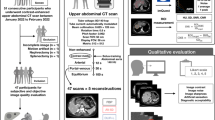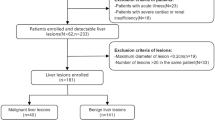Abstract
Objectives
To evaluate a novel deep learning image reconstruction (DLIR) technique for dual-energy CT (DECT) derived virtual monoenergetic (VM) images compared to adaptive statistical iterative reconstruction (ASIR-V) in low kiloelectron volt (keV) images.
Methods
We analyzed 30 venous phase acute abdominal DECT (80/140 kVp) scans. Data were reconstructed to ASIR-V and DLIR-High at four different keV levels (40, 50, 74, and 100) with 1- and 3-mm slice thickness. Quantitative Hounsfield unit (HU) and noise assessment were measured within the liver, aorta, fat, and muscle. Subjective assessment of image noise, sharpness, texture, and overall quality was performed by two board-certified radiologists.
Results
DLIR reduced image noise by 19.9–35.5% (p < 0.001) compared to ASIR-V in all reconstructions at identical keV levels. Contrast-to-noise ratio (CNR) increased by 49.2–53.2% (p < 0.001) in DLIR 40-keV images compared to ASIR-V 50 keV, while no significant difference in noise was identified except for 1 and 3 mm in aorta and for 1-mm liver measurements, where ASIR-V 50 keV showed 5.5–6.8% (p < 0.002) lower noise levels. Qualitative assessment demonstrated significant improvement particularly in 1-mm reconstructions (p < 0.001). Lastly, DLIR 40 keV demonstrated comparable or improved image quality ratings when compared to ASIR-V 50 keV (p < 0.001 to 0.22).
Conclusion
DLIR significantly reduced image noise compared to ASIR-V. Qualitative assessment showed that DLIR significantly improved image quality particularly in thin sliced images. DLIR may facilitate 40 keV as a new standard for routine low-keV VM reconstruction in contrast-enhanced abdominal DECT.
Key Points
• DLIR enables 40 keV as the routine low-keV VM reconstruction.
• DLIR significantly reduced image noise compared to ASIR-V, across a wide range of keV levels in VM DECT images.
• In low-keV VM reconstructions, improvements in image quality using DLIR were most evident and consistent in 1-mm sliced images.



Similar content being viewed by others
Abbreviations
- ASIR-V:
-
Adaptive statistical iterative reconstruction
- CNR:
-
Contrast to noise ratio
- DECT:
-
Dual-energy CT
- DLIR:
-
Deep learning image reconstruction
- FBP:
-
Filter backprojection
- HU:
-
Hounsfield unit
- keV:
-
Kiloelectron volt
- kVp:
-
Kilovoltage peak
- ROI:
-
Region of interest
- SNR:
-
Signal to noise ratio
- VM:
-
Virtual monoenergetic
References
McCollough CH, Leng S, Yu L, Fletcher JG (2015) Dual- and multi-energy CT: principles, technical approaches, and clinical applications. Radiology 276:637–653
Botsikas D, Triponez F, Boudabbous S, Hansen C, Becker CD, Montet X (2014) Incidental adrenal lesions detected on enhanced abdominal dual-energy CT: can the diagnostic workup be shortened by the implementation of virtual unenhanced images? Eur J Radiol 83:1746–1751
Xu JJ, Taudorf M, Ulriksen PS et al (2020) Gastrointestinal applications of iodine quantification using dual-energy CT: a systematic review. Diagnostics 10:814
Hyodo T, Yada N, Hori M et al (2017) Multimaterial decomposition algorithm for the quantification of liver fat content by using fast-kilovolt-peak switching dual-energy CT: clinical evaluation. Radiology 283:108–118
Lourenco PDM, Rawski R, Mohammed MF, Khosa F, Nicolaou S, McLaughlin P (2018) Dual-energy CT iodine mapping and 40-keV monoenergetic applications in the diagnosis of acute bowel ischemia. AJR Am J Roentgenol 211:564–570.
Albrecht MH, Vogl TJ, Martin SS et al (2019) Review of clinical applications for virtual monoenergetic dual-energy CT. Radiology 293:260–271
Husarik DB, Gordic S, Desbiolles L et al (2015) Advanced virtual monoenergetic computed tomography of hyperattenuating and hypoattenuating liver lesions: ex-vivo and patient experience in various body sizes. Invest Radiol 50:695–702
De Cecco CN, Caruso D, Schoepf UJ et al (2018) A noise-optimized virtual monoenergetic reconstruction algorithm improves the diagnostic accuracy of late hepatic arterial phase dual-energy CT for the detection of hypervascular liver lesions. Eur Radiol 28:3393–3404
Geyer LL, Schoepf UJ, Meinel FG et al (2015) State of the art: iterative CT reconstruction techniques. Radiology 276:339–357
Padole A, Ali Khawaja RD, Kalra MK, Singh S (2015) CT radiation dose and iterative reconstruction techniques. AJR Am J Roentgenol 204:W384–W392
Chen L-H, Jin C, Li J-Y et al (2018) Image quality comparison of two adaptive statistical iterative reconstruction (ASiR, ASiR-V) algorithms and filtered back projection in routine liver CT. Br J Radiol 91:20170655
Ren Z, Zhang X, Hu Z et al (2019) Application of adaptive statistical iterative reconstruction-V with combination of 80 kV for reducing radiation dose and improving image quality in renal computed tomography angiography for slim patients. Acad Radiol 26:e324–e332
McCollough CH, Yu L, Kofler JM et al (2015) Degradation of CT low-contrast spatial resolution due to the use of iterative reconstruction and reduced dose levels. Radiology 276:499–506
Hsieh J, Liu E, Nett B, Tang J, Thibault JB, Sahney S (2019) A new era of image reconstruction: TrueFidelity TM Technical white paper on deep learning image reconstruction. Available via https://www.gehealthcare.com/-/jssmedia/040dd213fa89463287155151fdb01922.pdf
Sakabe D, Funama Y, Taguchi K et al (2018) Image quality characteristics for virtual monoenergetic images using dual-layer spectral detector CT: comparison with conventional tube-voltage images. Phys Med 49:5–10
Fernandez-Velilla Cepria E, González-Ballester MÁ, Quera Jordana J et al (2021) Determination of the optimal range for virtual monoenergetic images in dual-energy CT based on physical quality parameters. Med Phys 48:5085–5095
Noda Y, Kawai N, Nagata S et al (2021) Deep learning image reconstruction algorithm for pancreatic protocol dual-energy computed tomography: image quality and quantification of iodine concentration. Eur Radiol. https://doi.org/10.1007/s00330-021-08121-3
Park C, Choo KS, Jung Y, Jeong HS, Hwang JY, Yun MS (2021) CT iterative vs deep learning reconstruction: comparison of noise and sharpness. Eur Radiol 31:3156–3164.
Likert R (1932) A technique for the measurement of attitudes. Arch Psychol 22 140:55
Nam JG, Hong JH, Kim DS, Oh J, Goo JM (2021) Deep learning reconstruction for contrast-enhanced CT of the upper abdomen: similar image quality with lower radiation dose in direct comparison with iterative reconstruction. Eur Radiol 31:5533–5543.
Kim JH, Yoon HJ, Lee E, Kim I, Cha YK, Bak SH (2021) Validation of deep-learning image reconstruction for low-dose chest computed tomography scan: emphasis on image quality and noise. Korean J Radiol 22:131–138.
Brown H, Prescott R (2015), Applied mixed models in medicine. Statistics in Practice, 3 edn, John Wiley & Sons Inc. C. https://doi.org/10.1002/978111877821
Cao L, Liu X, Li J et al (2021) A study of using a deep learning image reconstruction to improve the image quality of extremely low-dose contrast-enhanced abdominal CT for patients with hepatic lesions. Br J Radiol 94:20201086
Njølstad T, Schulz A, Godt JC et al (2021) Improved image quality in abdominal computed tomography reconstructed with a novel deep learning image reconstruction technique - initial clinical experience. Acta Radiol open 10:20584601211008390–20584601211008390
Martin SS, Pfeifer S, Wichmann JL et al (2017) Noise-optimized virtual monoenergetic dual-energy computed tomography: optimization of kiloelectron volt settings in patients with gastrointestinal stromal tumors. Abdom Radiol (NY) 42:718–726
Lam S, Gupta R, Levental M, Yu E, Curtin HD, Forghani R (2015) Optimal virtual monochromatic images for evaluation of normal tissues and head and neck cancer using dual-energy CT. AJNR Am J Neuroradiol 36:1518 LP–1524
Majeed NF, Ali SM, Therrien J, Wald C, Wortman JR (2021) Virtual monoenergetic spectral detector CT for preoperative ct angiography in liver donors. Curr Probl Diagn Radiol. https://doi.org/10.1067/j.cpradiol.2021.10.001
Park J, Kim SH, Han JK (2019) Combined application of virtual monoenergetic high keV images and the orthopedic metal artifact reduction algorithm (O-MAR): effect on image quality. Abdom Radiol (NY) 44:756–765
Shao Y-H, Tsai K, Kim S, Wu YJ, Demissie K (2019) Exposure to tomographic scans and cancer risks. JNCI Cancer Spectr 4:pkz072
Sun J, Li H, Wang B et al (2021) Application of a deep learning image reconstruction (DLIR) algorithm in head CT imaging for children to improve image quality and lesion detection. BMC Med Imaging 21:108
Yoshida R, Usui K, Katsunuma Y, Honda H, Hatakeyama K (2020) Reducing contrast dose using virtual monoenergetic imaging for aortic CTA. J Appl Clin Med Phys 21:272–277.
Ghandour A, Sher A, Rassouli N, Dhanantwari A, Rajiah P (2018) Evaluation of virtual monoenergetic images on pulmonary vasculature using the dual-layer detector-based spectral computed tomography. J Comput Assist Tomogr 42:858–865.
Szczykutowicz TP, Nett B, Cherkezyan L et al (2021) Protocol optimization considerations for implementing deep learning CT reconstruction. AJR Am J Roentgenol 216:1668–1677
Funding
The authors state that this work has not received any funding.
Author information
Authors and Affiliations
Corresponding author
Ethics declarations
Guarantor
The scientific guarantor of this publication is: Dr. Peter Sommer Ulriksen Department of Diagnostic Radiology, Rigshospitalet, Copenhagen, Denmark
Conflict of interest
The authors of this manuscript declare no relationships with any companies whose products or services may be related to the subject matter of the article.
Statistics and biometry
Professor Esben Budtz-Jørgensen (Section of Biostatistics, Department of Public Health, University of Copenhagen, Denmark) kindly provided statistical advice for this manuscript. He is also one of the authors in this study.
Informed consent
The study received approval from the Institutional Review Board as well as the approval from the Regional Committee on Research Ethics
Ethical approval
Institutional Review Board approval was obtained.
Methodology
• retrospective
• observational
• performed at one institution
Additional information
Publisher’s note
Springer Nature remains neutral with regard to jurisdictional claims in published maps and institutional affiliations.
Rights and permissions
Springer Nature or its licensor holds exclusive rights to this article under a publishing agreement with the author(s) or other rightsholder(s); author self-archiving of the accepted manuscript version of this article is solely governed by the terms of such publishing agreement and applicable law.
About this article
Cite this article
Xu, J.J., Lönn, L., Budtz-Jørgensen, E. et al. Quantitative and qualitative assessments of deep learning image reconstruction in low-keV virtual monoenergetic dual-energy CT. Eur Radiol 32, 7098–7107 (2022). https://doi.org/10.1007/s00330-022-09018-5
Received:
Revised:
Accepted:
Published:
Issue Date:
DOI: https://doi.org/10.1007/s00330-022-09018-5




